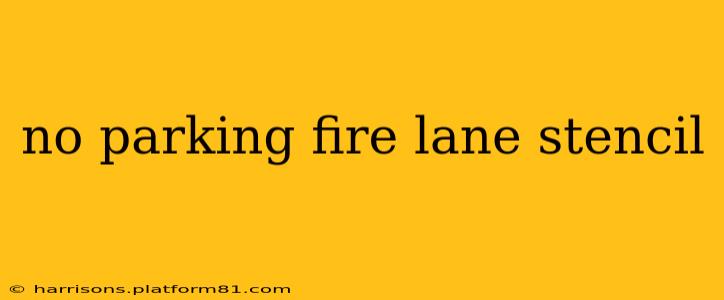Fire lanes are critical for emergency vehicle access, saving lives and property in emergencies. Obstructing a fire lane can lead to hefty fines and even more serious consequences. This guide will cover everything you need to know about "no parking fire lane stencil"s, from their importance to legal implications and best practices for placement.
What is a Fire Lane Stencil?
A fire lane stencil is a reusable template used to create clear and highly visible markings on the ground, indicating areas designated as fire lanes. These stencils are typically made of durable materials like plastic or metal and are designed to be used with paint, ensuring the markings are long-lasting and weather-resistant. The stencil itself will contain the words "NO PARKING FIRE LANE" or a similar message, often accompanied by a universally understood symbol.
Why are Fire Lane Stencils Important?
Fire lane stencils are crucial for several reasons:
- Emergency Vehicle Access: Clear markings ensure that emergency vehicles, like fire trucks and ambulances, can quickly and easily access buildings and areas in case of fire or other emergencies. Seconds can mean the difference between life and death, and obstructed access can have devastating consequences.
- Safety: Properly marked fire lanes reduce the risk of accidents and injuries. Vehicles parked in fire lanes create obstacles and hazards, increasing the likelihood of collisions, especially during emergency situations.
- Legal Compliance: Most jurisdictions have strict regulations regarding fire lane access, mandating the clear marking of these areas. Failure to comply can result in significant penalties.
- Property Protection: Clear fire lanes help protect buildings and surrounding properties from fire damage. Quick access allows firefighters to effectively contain and extinguish fires before they spread.
What are the Legal Implications of Blocking a Fire Lane?
The legal consequences of parking or obstructing a fire lane can be severe and vary by location. Generally, penalties include:
- Fines: Significant fines are commonly levied for blocking a fire lane, often escalating with repeat offenses.
- Towing: Vehicles obstructing fire lanes are frequently towed at the owner's expense.
- Legal Action: In some cases, more serious legal action, such as court appearances and further penalties, may result.
It's crucial to understand local laws and regulations regarding fire lane access to avoid any legal issues.
What are the different types of fire lane stencils available?
Several types of fire lane stencils are available, varying in material, size, and design. Common choices include:
- Plastic Stencils: These are widely used due to their affordability and durability.
- Metal Stencils: Metal stencils are more robust and withstand heavier use, making them ideal for high-traffic areas.
- Reflective Stencils: Reflective stencils enhance visibility, especially at night or in low-light conditions.
How do I choose the right fire lane stencil for my needs?
Choosing the right stencil depends on several factors:
- Size of the fire lane: Ensure the stencil is appropriately sized to clearly mark the designated area.
- Material durability: Consider the level of traffic and environmental conditions to select a durable stencil.
- Visibility: Opt for reflective stencils or high-contrast paint colors for maximum visibility.
Where can I buy fire lane stencils?
Fire lane stencils are readily available from various sources, including online retailers, safety equipment suppliers, and local hardware stores. Always ensure the stencil complies with local regulations.
What kind of paint should I use with a fire lane stencil?
Choose a high-quality paint suitable for outdoor use and designed for pavement markings. Consider using reflective paint for increased visibility.
By using high-quality fire lane stencils and adhering to local regulations, you can ensure the safety and well-being of your community. Remember that preventing the obstruction of fire lanes is not just a matter of compliance; it's a matter of life and safety.
